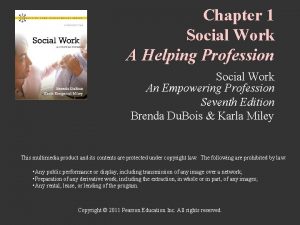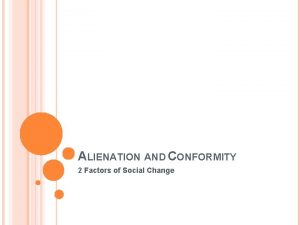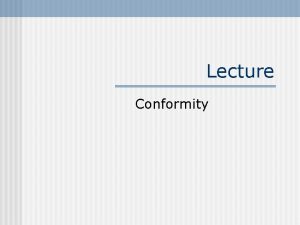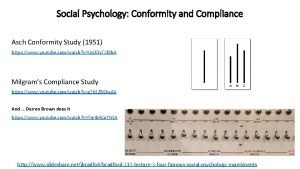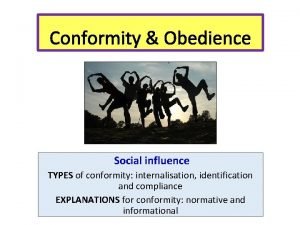Forces of Social Change Conformity Alienation Alienation of


















- Slides: 18

Forces of Social Change Conformity & Alienation

Alienation of the People Sociologist Emile Durkheim coined the word “anomie” to describe the conditions of the industrial workers who had no roots or norms as they struggled in their lives Sociologist Karl Marx took this term and applied it to working people or “proletariat”. He claimed the workers were exploited and controlled, and as a result could never reach full potential Alienations has been expanded it mean anyone who does not share the major values of society and feels like an outsider. Alienation refers to isolation from a group or an activity to which one should belong or in which one should be involved. Loss or lack of sympathy; estrangement.

Negative Effects of Alienation Create anarchists – people who act against society because they were alienated. Extreme example: (1) Columbine shooters (2) Theodore Kaczynski - also known as the Unabomber, an American terrorist who attempted to fight against what he perceived as the evils of technological progress by sending mail bombs to various people. Alienation can be so severe that people just give up and accept life in the margins of society (social roles, crime, or poverty).

Positive Aspect of Alienation Can be a positive motivator for social change. Push for reform/action It can create reformers or people who create outstanding ideas Reformers can bring together community

When marginalized or alienated groups work towards social change

Women’s Suffrage Movement

Conformity of the People Conformity is the act of maintaining a certain degree of similarity (in clothing, manners, behaviors, etc. ) to those in your general social circles, to those in authority, or to the general status quo. Usually, conformity implies a tendency to submit to others in thought and behaviour other than simply clothing choice

Conformity: Good or Bad? Positive Aspects • Encourages polite social interactions and creates predictable behaviour – people feel comfortable and secure. • Promotes social solidarity – creates community Negative Aspects • Conformity generally discourages social change as people generally desire to fit in. Conforming to others tends stifle social change because everyone is behaving the same • can encourage people to accept practices that they know, or suspect are wrong or immoral • Pressure to conform can result in negative behaviours such as increased racism, bullying, sexism

Civil Rights Movement


The Pressure to Conform M. Deutsch and H. B Gerrard (1955) identified two forms of pressures to conform to society’s norms: Informational Influence: human desire to accept information that another, admired person tells us is valid (ie. Parent, teacher, coach) Example: If we admire our nations’ leader we are going to believe the information he tells. Some people are very good at convincing others. Normative Influence: pressure to conform to the positive expectations of others (ie. Follow in footsteps of parent’s career). Example: An example would be to work really hard on your essay because you want your teacher to think highly of you.

Resisting Conformity Deviance - describes actions or behaviours that violate social norms, including formallyenacted rules (e. g. , crime), as well as informal norms. Deviance creates social change – some cases necessary for social change to occur


Freedom Ride A Greyhound bus with 14 members of an interracial group that was part of the Freedom Ride was firebombed on May 14, 1961, outside Anniston, Ala.

Tiananmen Square Protest (1989)

Turn-and-Talk Does Protesting Change anything?

Gay Rights Movement

 Conformity and alienation
Conformity and alienation What is gestus
What is gestus Amy jl baker
Amy jl baker Involuntary alienation real estate
Involuntary alienation real estate Brechtian alienation effect
Brechtian alienation effect Alienation in metamorphosis
Alienation in metamorphosis Brecht placards
Brecht placards Alienation as a form of self-protection
Alienation as a form of self-protection Parental alienation lawyer logan county
Parental alienation lawyer logan county Occupational alienation
Occupational alienation Dialectical materialism by karl marx
Dialectical materialism by karl marx Herbert spencer theory
Herbert spencer theory Social work: an empowering profession 9th edition chapter 1
Social work: an empowering profession 9th edition chapter 1 What do you mean by a like-parallel system?
What do you mean by a like-parallel system? The forces shown above are
The forces shown above are Intramolecular forces vs intermolecular
Intramolecular forces vs intermolecular Intermolecular vs intramolecular
Intermolecular vs intramolecular Covalent bond intermolecular forces
Covalent bond intermolecular forces Force and motion
Force and motion












